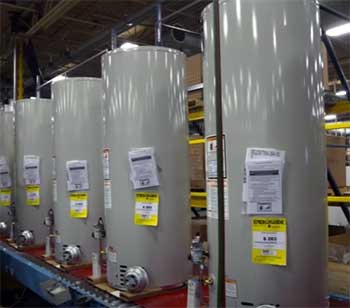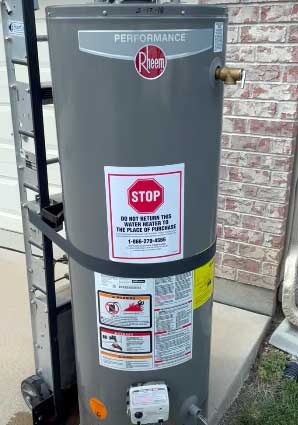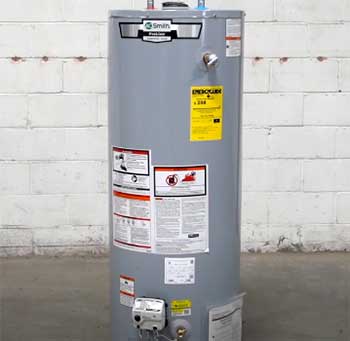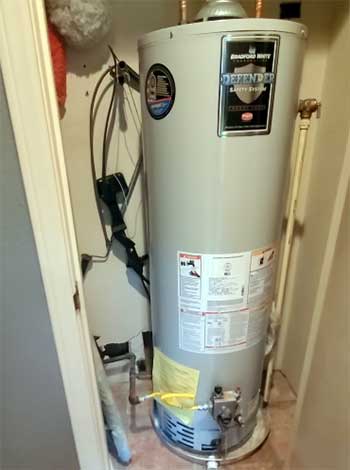When my old water heater started failing, I faced a daunting task: picking a new one. Cold showers and strange noises pushed me to research Bradford White, Rheem, and A.O. Smith—three giants in the water heater world.
Each promised reliability, efficiency, and performance, but which would best fit my home?
In this article, I’ll share my journey, comparing their features, weighing pros and cons, and helping you choose the right water heater. From durability to cost, I’ll break it down to guide you toward a smart decision.
A Brief Comparison Table
| Feature | Bradford White | Rheem | A.O. Smith |
| Product Range | Tank, tankless, gas, electric, solar | Tank, tankless, hybrid, solar, propane | Tank, tankless, hybrid, gas, electric |
| Warranty | 6–10 years (extendable) | 6–12 years (some lifetime on Marathon) | 5–12 years |
| Energy Efficiency (UEF) | 0.54–0.93, Energy Star on select models | 0.55–0.96, Energy Star on select models | 0.55–0.95, Energy Star on select models |
| Durability Features | Vitraglas lining, Hydrojet system | Marathon non-metallic tanks, EcoNet | Blue Diamond coating, self-cleaning |
| Price Range (Tank) | $800–$2,500 (mid-to-high) | $400–$3,000 (budget-friendly) | $700–$3,500 (mid-to-high) |
| Availability | Licensed dealers only | Home Depot, wholesalers, online | Lowe’s, online, wholesalers |
| Smart Technology | Limited smart controls | EcoNet Wi-Fi, smart diagnostics | Some Wi-Fi-enabled models |
| Installation | Professional only | DIY or professional | DIY or professional |
My Quest For The Perfect Water Heater
A few months ago, my water heater gave up—lukewarm showers and odd gurgling sounds were my cue to act. I needed a reliable replacement but was overwhelmed by choices. After hours of research, I focused on Bradford White, Rheem, and A.O. Smith.
Each brand had a strong reputation, but their strengths varied. My goal was a heater that balanced efficiency, durability, and cost for my family of four. Let me share what I discovered about each brand’s offerings.
Bradford White: The Contractor’s Choice
Bradford White, founded in 1881, is a name plumbers swear by. This American company focuses on contractor-grade quality, selling exclusively through licensed professionals.
At first, I worried this would inflate costs, but their reputation for durability made me curious.
Pros of Bradford White

- Exceptional Build Quality: Bradford White’s tanks are built like fortresses. Their Vitraglas lining, a glass-like coating, protects against corrosion, especially in my area’s hard water. I learned this can extend tank life significantly, reducing the risk of leaks.
- Innovative Hydrojet System: The Hydrojet Total Performance System was a game-changer for me. It uses a high-pressure water jet to reduce sediment buildup, which can clog tanks and lower efficiency. This feature means less maintenance and a longer lifespan.
- Enhanced Safety Features: Safety was a big concern since my heater is in the garage. The Defender Safety System prevents flammable vapor ignition, a rare but serious risk. Knowing my family is safer gave me peace of mind.
- Strong Warranty Options: Bradford White offers 6–10-year warranties, with the option to extend coverage. This flexibility reassured me, as I could protect my investment for longer if needed.
- Energy Star Certification: Many models are Energy Star certified, with UEF ratings from 0.54 to 0.93. This translates to lower utility bills, especially for gas models like the RG240 series, which I considered for my home.
- Made in the USA: As someone who values local manufacturing, I appreciated that Bradford White produces its heaters in the USA. It felt like a vote for quality craftsmanship.
Cons of Bradford White
- Higher Upfront Costs: The biggest hurdle was price. Tank models range from $800 to $2,500, and the professional-only installation adds $500–$1,500. For my budget, this was a stretch compared to other brands.
- Limited Smart Technology: Bradford White lags in smart features. There’s no Wi-Fi or app control, which disappointed me as a tech enthusiast. I wanted to monitor my heater remotely, but this wasn’t an option.
- Tricky Anode Rod Replacement: The anode rod, which prevents tank corrosion, is integrated into the hot water outlet. In tight spaces, replacement requires significant clearance, potentially needing a plumber and adding costs.
- Restricted Availability: You can’t buy Bradford White at big-box stores like Home Depot. The dealer-only model ensures quality installation but limits convenience and increases costs if you’re not near a supplier.
- Mixed Reliability Reports: While plumbers love them, some online reviews mentioned igniter failures or leaks within 6–8 years. This inconsistency made me question whether every model lives up to the brand’s reputation.
Key Features
- Vitraglas Tank Lining: Shields tanks from corrosion, ideal for hard water.
- Hydrojet System: Reduces sediment for better efficiency and longevity.
- Defender Safety System: Prevents flammable vapor ignition for safety.
- Energy Star Models: UEF up to 0.93 for energy savings.
- American-Made: Appeals to those prioritizing domestic production.
- High-Capacity Options: Tanks up to 120 gallons for large households.
Rheem: The Accessible Innovator
Rheem, founded in 1925, is a name I recognized from Home Depot shelves. Their wide product range and focus on innovation made them appealing, especially since I love tech-driven solutions.
Pros of Rheem

- Budget-Friendly Pricing: Rheem’s affordability was a major draw. Tank models start at $400, with high-end units reaching $3,000. This range made it easier to fit into my budget compared to Bradford White.
- Versatile Product Line: Rheem offers everything: tank, tankless, hybrid, solar, and propane heaters, with capacities from 10 to 120 gallons. Whether you’re a single person or a large family, there’s a model for you.
- Marathon Series Durability: The Marathon series, with non-metallic tanks, is marketed as rust-proof. I was impressed by claims that it could last a lifetime, especially for electric heaters in corrosive environments.
- EcoNet Smart Technology: Rheem’s EcoNet system was a highlight. It lets you monitor water usage, detect leaks, and adjust settings via an app. For my busy household, this remote control was a big plus.
- High Energy Efficiency: Rheem’s UEF ratings reach 0.96, and their hybrid models, like the Prestige series, can cut energy costs by up to 40%. This was tempting as I looked to lower my utility bills.
- Wide Availability: I could buy Rheem heaters at Home Depot, online, or through wholesalers. This accessibility made it easy to compare models and prices without hunting down a dealer.
Cons of Rheem
- Gas Model Reliability Issues: Plumbers warned me about Rheem’s gas models, particularly faulty gas control valves. Online reviews echoed this, with some users reporting failures within 3–5 years, especially in the Performance series.
- Budget Models Lack Quality: The lower-end Performance models, while affordable, felt like a gamble. Complaints about leaks and short lifespans made me wary of opting for the cheapest options.
- Brand-Specific Parts: Rheem’s replacement parts are proprietary, meaning repairs could be delayed if parts aren’t in stock. This was a concern for long-term maintenance.
- Warranty Limitations: While Rheem offers 6–12-year warranties (and lifetime on Marathon models), budget models often have shorter coverage. I worried about repair costs if issues arose early.
- Noise in Some Models: Some users reported noisy operation, especially with gas models. For a heater in my basement, this wasn’t a dealbreaker, but it could be for others.
Key Features
- Marathon Series: Non-metallic tanks resist rust and corrosion.
- EcoNet Smart Technology: Wi-Fi-enabled monitoring and diagnostics.
- High Efficiency: UEF up to 0.96, with hybrids saving up to 40% on energy.
- Wide Availability: Sold at Home Depot, online, and wholesalers.
- Versatile Range: Tank, tankless, hybrid, and solar options.
- Leak Detection: EcoNet alerts prevent water damage.
A.O. Smith: The Tech-Savvy Workhorse
A.O. Smith, established in 1874, is a powerhouse with a knack for innovation. Their acquisition of brands like Lochinvar boosted their reputation, and their tech-forward approach intrigued me.
Pros of A.O. Smith

- Advanced Durability Features: The Blue Diamond glass coating protects tanks from corrosion, and self-cleaning systems reduce scale buildup. I estimated a lifespan of 10–20 years, which felt reassuring.
- Vertex Series Performance: The Vertex series, with advanced burner technology, delivers rapid heating and high efficiency (UEF up to 0.95). For my family’s high hot water demand, this was a major selling point.
- Energy Star Certification: Many A.O. Smith models are Energy Star certified, qualifying for rebates in my area. Their hybrid models, like the Voltex, promised significant energy savings.
- Accessible Purchase Options: I found A.O. Smith heaters at Lowe’s, online, and through wholesalers. This convenience made it easy to shop around and compare prices.
- Commercial-Grade Components: A.O. Smith uses heavy-duty parts, even in residential models. This durability gave me confidence in their long-term performance.
- Wi-Fi Connectivity: Select models offer Wi-Fi, letting you monitor and control the heater via an app. While not as robust as Rheem’s EcoNet, it was a step up from Bradford White.
Cons of A.O. Smith
- Premium Model Costs: High-end models like the Vertex series can cost $2,000–$3,500, which strained my budget. Budget models, while cheaper, lack features like Wi-Fi or dual elements.
- Past Quality Control Issues: A.O. Smith has faced recalls, particularly for gas models with faulty burners. Though recent models seem improved, this history made me cautious.
- Noisy Operation: Some users reported humming or buzzing from damper plates, especially in gas models. This could be an issue in quiet homes.
- Inconsistent Warranty Terms: Warranties range from 5–12 years, but budget models often have shorter coverage. I wished for more consistency across their lineup.
- Electric Model Limitations: For electric heaters, Rheem’s Marathon series felt more reliable. A.O. Smith’s electric models are solid but don’t stand out as much.
Key Features
- Blue Diamond Coating: Enhances tank durability against corrosion.
- Self-Cleaning Systems: Reduces sediment for longer lifespan.
- Vertex Series: High-efficiency gas models with rapid heating.
- Energy Star Certification: Qualifies for rebates, UEF up to 0.95.
- Commercial-Grade Build: Designed for long-term reliability.
- Wi-Fi Options: Select models offer remote monitoring.
Comparing Bradford White, Rheem And A.O. Smith
As I evaluated these brands, I focused on reliability, efficiency, cost, and ease of use. Here’s how they compared.

- Reliability: Reliability was non-negotiable. Bradford White’s Vitraglas and Hydrojet systems shine in hard water, and plumbers rave about their build. However, some gas models fail early. Rheem’s Marathon series is unbeatable for electric heaters, but gas models suffer from valve issues. A.O. Smith’s commercial-grade parts and self-cleaning tech make it reliable, though past recalls linger. I’d rank Bradford White first for durability, A.O. Smith second, and Rheem third for gas but first for electric.
- Energy Efficiency: With utility bills climbing, efficiency was key. Rheem and A.O. Smith lead with UEF ratings up to 0.96 and 0.95, respectively. Their hybrid models save significantly. Bradford White’s UEF (up to 0.93) is solid but not cutting-edge. For energy savings, Rheem or A.O. Smith are top choices.
- Cost and Value: Rheem’s low starting price ($400) and availability make it budget-friendly. A.O. Smith’s range ($700–$3,500) offers value for tech-heavy models. Bradford White’s higher costs ($800–$2,500) and pro-only installation make it priciest. A.O. Smith felt like the best balance for me.
- Ease of Use and Installation: Rheem’s DIY options and EcoNet system make it user-friendly. A.O. Smith matches this with Wi-Fi models and easy access. Bradford White’s pro-only model and lack of smart tech make it less convenient. For DIYers, Rheem or A.O. Smith win.
Real-World Scenarios: What Fits Your Home?
I considered my family of four’s needs: frequent showers, laundry, and dishes. Here’s how each brand fits:
- Small Households (1–2 people): Rheem’s tankless or 30-gallon tanks are affordable and efficient.
- Medium Households (3–4 people): A.O. Smith’s Vertex or hybrid models handle high demand.
- Large Households: Bradford White’s high-capacity tanks (up to 120 gallons) are ideal.
- Tech Enthusiasts: Rheem’s EcoNet and A.O. Smith’s Wi-Fi models shine.
- Hard Water Areas: Bradford White’s Hydrojet and A.O. Smith’s self-cleaning tech excel.
My Decision-Making Process
I chose A.O. Smith’s Vertex for its efficiency and rapid heating, fitting my budget and needs. Rheem’s affordability and tech were tempting, but gas model concerns held me back.
Bradford White’s durability was great, but costs and installation were drawbacks. Your priorities—durability, tech, or budget—will guide your choice.
Frequently Asked Questions (FAQ)
Bradford White excels in durability, especially in hard water, but Rheem offers better affordability and smart tech. Choose based on longevity vs. cost and features.
A.O. Smith offers advanced tech and efficiency, while Bradford White prioritizes durability. Pick A.O. Smith for features, Bradford White for tough water conditions.
Rheem is great for budgets and tech lovers, while A.O. Smith offers reliability and efficiency for gas models. Rheem’s Marathon excels for electric.
Bradford White leads for durability, A.O. Smith for consistency, and Rheem for electric models like Marathon. Maintenance is key for all.
Conclusion: Your Path To The Perfect Water Heater
Choosing between Bradford White, Rheem, and A.O. Smith is about matching your needs. My journey showed me each brand’s strengths: Bradford White’s rugged build, Rheem’s affordability and tech, and A.O. Smith’s balance of innovation and reliability.
Consider your household size, water quality, and budget. You deserve a water heater that delivers hot showers and low bills. Take time to compare and choose what’s right for you.
